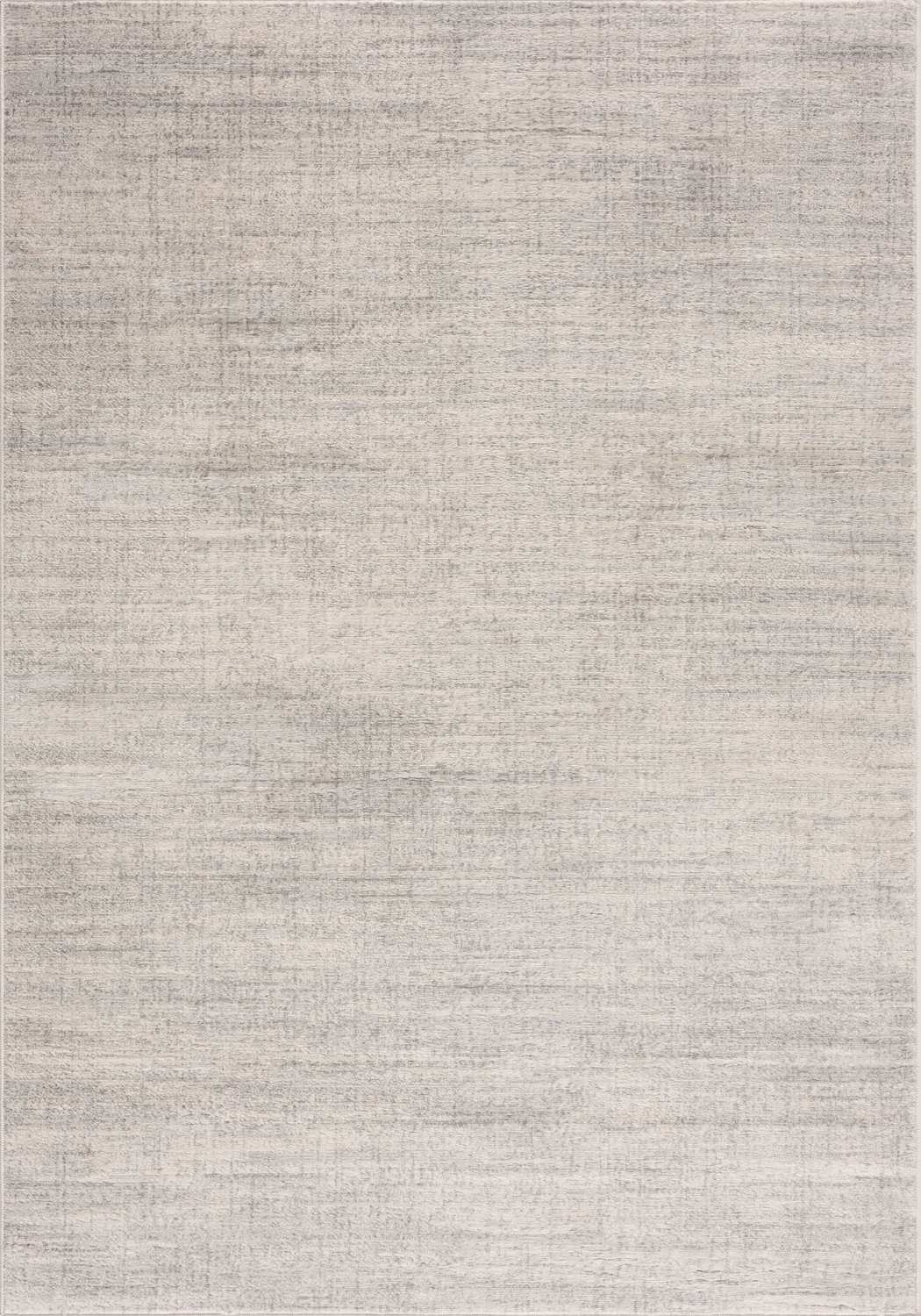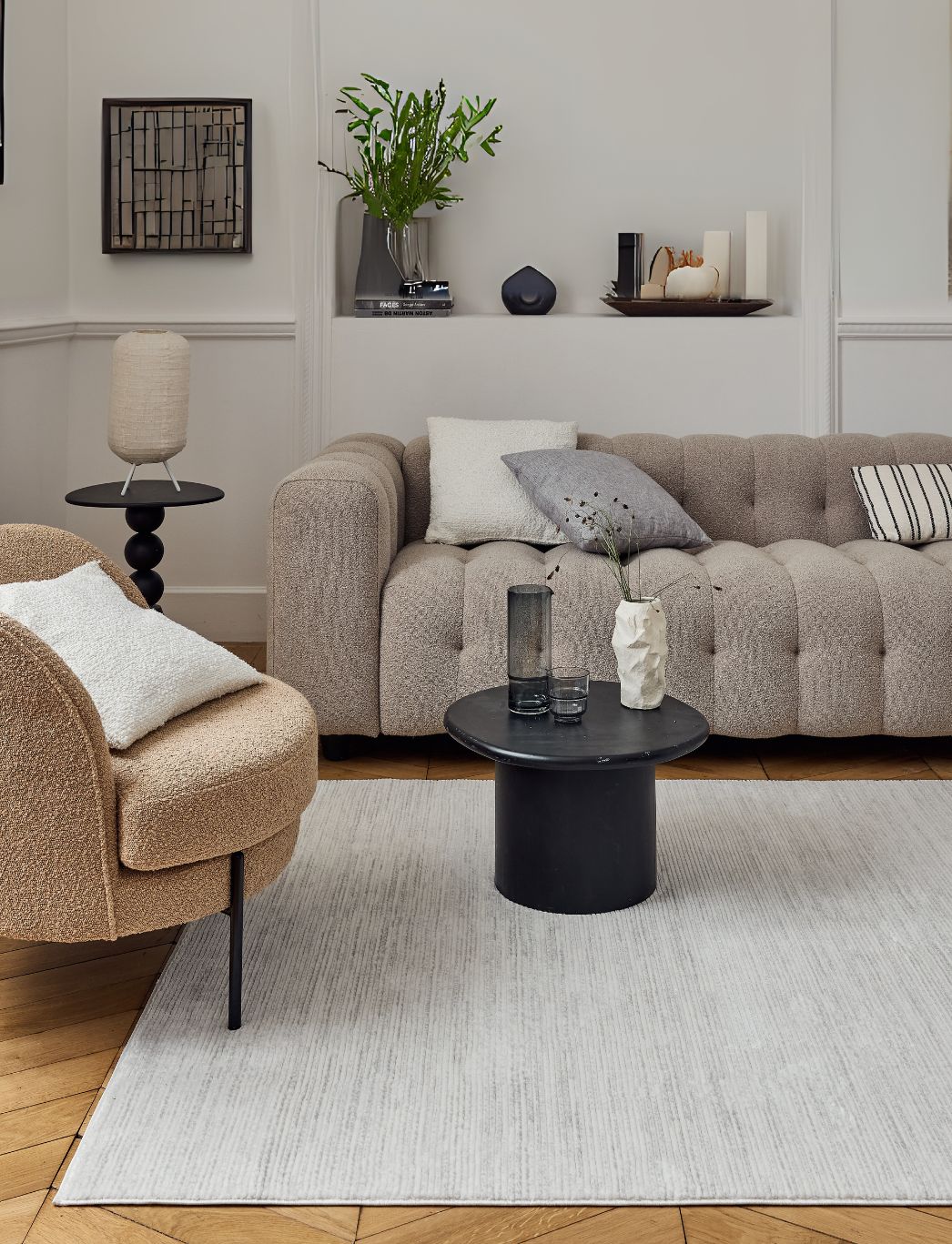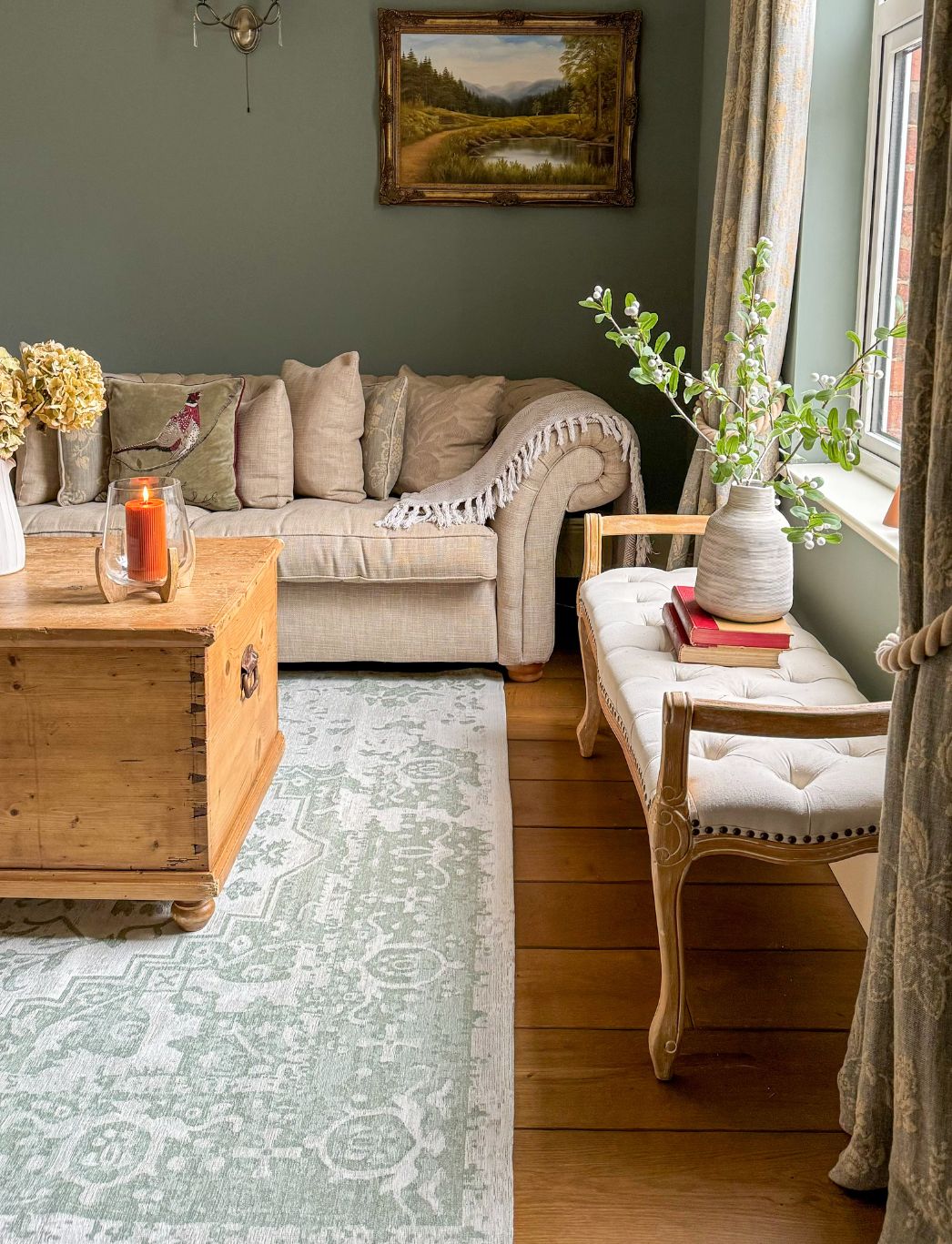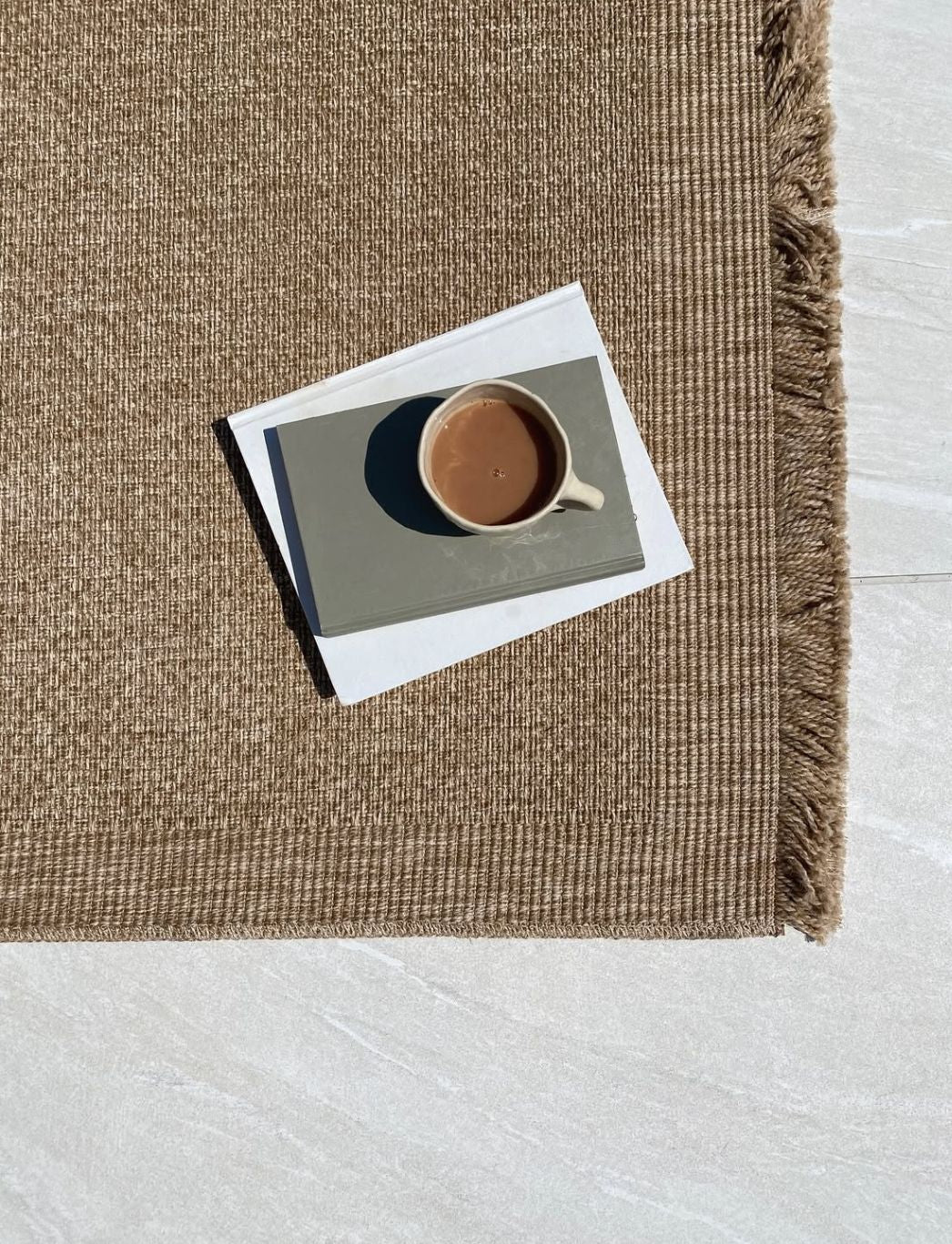Rug Care for Natural Fibre Rugs: Sisal, Seagrass, and Jute

Opting for natural fibre rugs can introduce texture, warmth, and a touch of elegance to any space. Crafted from eco-friendly, renewable materials like sisal, seagrass, and jute, these rugs are not only environmentally conscious but also exquisite.
However, caring for natural fibre rugs necessitates special attention and maintenance to preserve their pristine appearance and safeguard against potential issues like stains, mold, and mildew.
Here we'll unveil the secrets to establishing a comprehensive care regimen for your natural fibre rugs. We'll delve into the nuances of vacuuming, spot cleaning, and even dry cleaning these rugs. By adhering to these straightforward guidelines, you'll ensure the lasting beauty and longevity of your natural fibre rugs, enabling you to relish them for many years ahead.
How to Care for Natural Fibre Rugs?
Sisal, seagrass, and jute rugs, which fall under the category of natural fibre rugs, boast durability and an eco-friendly nature. However, safeguarding them against moisture, stains, and dirt necessitates specialised care and maintenance. Here, we share valuable insights and tips for the maintenance of these unique rug types.
1. Vacuum with a Soft Brush
Vacuum regularly with a suction-only vacuum or a soft brush attachment. This will help remove any loose dirt and dust from the rug and prevent it from settling into the fibres. Avoid using a beater bar or a rotating brush, as they can damage the rug.
2. Avoid Cleaning with Water
Do not clean with water. Sisal and jute rugs do not handle moisture well and can warp, shrink, or discolour when exposed to water. Instead, you should use a dry-cleaning method such as a Host Dry Cleaner Kit or a mild fabric detergent.
3. Immediately Clean Spills and Stains
Blot spills and stains immediately with a clean, white cloth or paper towel. Do not rub or scrub the spill, as this can spread the stain and damage the fibres. Use a mild soap or a Sisal Life Cleaner to treat the stain, and then dry the area with a hair dryer or a fan.
You can protect your rug from future spills and stains with a Sisal Life Protector. This is a spray that can be applied to the rug to create a barrier against liquids and dirt. You can either have it professionally applied or do it yourself with an easy-to-use bottle.
4. Place Natural Rugs in a Dry Area
Keep your rug in a dry area with low humidity. Avoid placing your rug in damp areas such as bathrooms, kitchens, or basements. Excess moisture can lead to unwelcome consequences like mold, mildew, and the deterioration of sisal fibres. Should your rug become wet, act swiftly to address the issue. You can expedite drying by either suspending it under the sun's warm embrace or employing the aid of a fan.
At The Rugs, we have a dazzling collection of rugs, with a variety of colours and mesmerising patterns. For special deals and design secrets, visit our website now.

How to Clean Pillow Stains: Effective Solutions for Stubborn Marks
Tackle unsightly pillow stains with these effective methods. Begin by identifying the stain type to choose the appropriate cleaning solution. For sweat and oil stains, create a paste using baking soda and water. Apply the paste to the stain, let it sit for 30 minutes, then brush off and vacuum. For food or beverage stains, use a mixture of washing-up liquid and warm water. Gently dab the stain with a clean cloth, working from the outside in. For tougher stains, consider using a specialised fabric stain remover. Always test any cleaning solution on a small, inconspicuous area first to ensure it doesn't damage the fabric.
How to Clean Pillow Cases: Maintaining Fresh and Hygienic Bedding
Keep your pillow cases clean and fresh with these simple steps. Wash pillow cases weekly to maintain hygiene. Use warm water and a mild detergent for regular washing. For stubborn stains, pre-treat with a mixture of baking soda and water. To prevent yellowing, add a cup of white vinegar to the rinse cycle. For delicate fabrics, opt for a gentle cycle or hand wash. Always check the care label for specific instructions. Air dry when possible to maintain fabric quality and reduce energy consumption. Iron on appropriate heat setting if desired for a crisp, clean look.
How to Clean Pillow Without Washing: Quick Refresh Techniques
Freshen up your pillows between washes with these simple methods. Start by vacuuming both sides of the pillow to remove dust and allergens. Sprinkle bicarbonate of soda over the pillow and let it sit for several hours to absorb odours. Vacuum thoroughly afterwards. For spot cleaning, use a mixture of mild soap and warm water. Dab gently with a clean cloth, being careful not to saturate the pillow. Air out your pillows in direct sunlight for a few hours to naturally disinfect and deodorise. Consider using a fabric freshener spray designed for bedding for a quick scent boost.
How to Clean Pillow in Washing Machine: Thorough Cleaning for Most Pillows
Effectively clean your pillows in the washing machine with these steps. First, check the care label to ensure machine washing is safe. Remove pillowcases and protectors. Use warm water and a mild detergent. Add a cup of white vinegar to the rinse cycle to help remove soap residue. Wash two pillows at a time to balance the load. Use the gentle cycle to prevent damage. For down or feather pillows, use a specialised detergent. Run an extra rinse cycle to ensure all soap is removed. Dry thoroughly on low heat with dryer balls to prevent clumping. Always ensure pillows are completely dry before use.
How to Clean Pillow Without Washing Machine: Hand-Washing Techniques
Clean your pillows effectively without a washing machine using these methods. Fill a large sink or bathtub with warm water and add a small amount of mild detergent. Submerge the pillow and gently squeeze to allow the soapy water to penetrate. For stubborn stains, use a soft-bristled brush to gently scrub. Rinse thoroughly with clean water until no soap remains. Press out excess water without wringing or twisting. Dry flat in direct sunlight, fluffing and turning occasionally for even drying. For non-washable pillows, spot clean with a damp cloth and mild soap solution, then air dry completely.

How to Clean Pillow Cases Yellow: Restoring Brightness to Dingy Fabrics
Revive yellowed pillow cases with these effective cleaning methods. Start by soaking the cases in a solution of hot water and oxygen-based bleach for several hours. For stubborn yellowing, create a paste with bicarbonate of soda and water, apply to the stained areas, and let sit before washing. Add a cup of white vinegar to the rinse cycle to help remove soap residue and brighten fabrics. For white pillow cases, use a bluing agent in the wash to counteract yellow tones. Dry in direct sunlight when possible, as UV rays can help naturally bleach and brighten fabrics.
How to Clean Pillow Top Mattress: Maintaining a Fresh Sleeping Surface
Keep your pillow top mattress clean and hygienic with these techniques. Start by vacuuming the entire surface thoroughly to remove dust and allergens. For spot cleaning, mix a solution of mild detergent and warm water. Dab the stained area gently with a clean cloth, being careful not to saturate the mattress. For odour removal, sprinkle bicarbonate of soda over the surface, let it sit for several hours, then vacuum thoroughly. Use a fabric freshener spray designed for mattresses for a quick refresh. Consider using a mattress protector to prevent future stains and extend the life of your pillow top mattress.
How to Clean Pillow Pets: Caring for Plush Companions
Keep your pillow pets clean and cuddly with these gentle cleaning methods. Check the care label first, as some may be machine washable. For surface cleaning, use a damp cloth with a mild soap solution to spot clean. For deeper cleaning, use a foam upholstery cleaner, working it gently into the fabric with a soft brush. Rinse by wiping with a clean, damp cloth. For machine-washable pillow pets, use a gentle cycle with cold water and mild detergent. Place in a mesh laundry bag to protect features. Air dry or tumble dry on low heat, reshaping as needed. Brush gently when dry to restore the plush texture.
How to Clean Pillow Covers: Maintaining Decorative and Functional Covers
Keep your pillow covers looking fresh with these cleaning tips. Always check the care label for specific instructions. For machine-washable covers, use a gentle cycle with cold water and mild detergent. Turn covers inside out before washing to protect any decorative elements. For delicate or non-washable covers, spot clean with a mixture of mild soap and water. Dab gently with a clean cloth, working from the outside of the stain inward. For stubborn stains, use a fabric stain remover designed for the specific fabric type. Air dry when possible, or tumble dry on low heat. Iron on appropriate setting if needed for a crisp look.
How to Clean Pillow Inserts: Refreshing the Core of Your Pillows
Maintain the freshness of your pillow inserts with these cleaning methods. For machine-washable inserts, use a gentle cycle with warm water and mild detergent. Add tennis balls or dryer balls to the dryer to help maintain loft. For foam inserts, spot clean with a mixture of mild soap and water, being careful not to saturate the foam. Allow to air dry completely before use. For down or feather inserts, use a specialised down detergent and wash on a gentle cycle. Dry thoroughly on low heat with dryer balls. For non-washable inserts, air out in sunlight periodically and use a fabric freshener spray designed for bedding.
How to Clean Sisal Rug Pet Stains: Effective Solutions for Natural Fibres
Tackle pet stains on sisal rugs with these targeted cleaning methods. Act quickly to blot up any liquid with clean, white cloths. Mix a solution of mild dish soap and warm water, avoiding oversaturation. Gently dab the stained area with the solution using a clean cloth. For odour removal, sprinkle bicarbonate of soda over the affected area, leave overnight, then vacuum thoroughly. For stubborn stains, consider using a specialised sisal cleaner. Always test cleaning solutions on an inconspicuous area first. Remember, sisal is sensitive to water, so use minimal moisture and ensure thorough drying to prevent damage.
Sisal Rug Care Products: Essential Tools for Maintaining Natural Fibre Rugs
Invest in the right products to keep your sisal rug looking its best. A sturdy vacuum cleaner with adjustable height settings is essential for regular maintenance. Look for pH-neutral cleaners specifically formulated for natural fibres. Dry cleaning kits designed for sisal can be effective for spot cleaning. Consider a natural fibre sealant to protect against spills and stains. Soft-bristled brushes are useful for gentle agitation during cleaning. For odour control, opt for enzyme-based deodorisers safe for natural fibres. Always have clean, white cloths on hand for blotting spills quickly.
Sisal Life Cleaner: Specialised Care for Long-Lasting Natural Rugs
Extend the life of your sisal rug with proper cleaning techniques. Regular vacuuming is crucial to prevent dirt from settling into fibres. For spills, blot immediately with clean, white cloths to absorb liquid. Use a pH-neutral cleaner specifically designed for sisal, following the manufacturer's instructions carefully. Avoid overwetting the rug, as sisal is sensitive to moisture. For deep cleaning, consider professional services experienced with natural fibres. Rotate your rug periodically to ensure even wear. Use furniture cups under heavy pieces to prevent permanent indentations in the sisal fibres.

Professional Sisal Carpet Cleaning: Expert Care for Natural Fibre Flooring
When your sisal carpet needs a thorough clean, professional services offer expert care. Look for cleaners specialising in natural fibres who understand sisal's unique properties. Professional cleaning typically involves dry extraction methods to minimise moisture exposure. Some services offer low-moisture cleaning techniques specifically developed for sisal. Discuss any stain treatments or protective coatings available. Ask about drying times and post-cleaning care to maintain your sisal carpet's appearance. Regular professional cleaning can extend the life of your sisal carpet and maintain its natural beauty.
Sisal Rug Care Near Me: Finding Local Expertise for Natural Fibre Maintenance
Locate expert care for your sisal rug in your local area. Search for carpet cleaning services that specifically mention experience with natural fibres or sisal. Check local home improvement stores for specialised sisal cleaning products and advice. Some flooring retailers offer maintenance services or can recommend trusted professionals. Consider mobile cleaning services that come to your home for convenient sisal rug care. Look for eco-friendly cleaning options that align with sisal's natural properties. Don't forget to check online reviews and ask for references before choosing a service provider.
Sisal Carpet Cleaning Kit: DIY Solutions for Natural Fibre Maintenance
Assemble a comprehensive sisal carpet cleaning kit for effective home maintenance. Include a high-quality vacuum cleaner with adjustable settings for gentle yet thorough cleaning. Add a soft-bristled brush for agitating dirt without damaging fibres. Include pH-neutral cleaning solutions specifically formulated for natural fibres. Keep clean, white cloths on hand for blotting spills quickly. A spray bottle for diluting cleaning solutions is useful for controlled application. Consider adding a natural fibre sealant for protection against future stains. Don't forget protective gloves and a small fan to aid in quick drying after spot cleaning.
Best Sisal Rug Cleaner: Top Choices for Natural Fibre Care
Select the best cleaner for your sisal rug to maintain its natural beauty. Look for pH-neutral formulas specifically designed for natural fibres. Opt for low-moisture or dry cleaning products to prevent water damage. Consider enzyme-based cleaners for effective stain and odour removal. Some of the best sisal cleaners come in powder form for easy application and removal. Look for products with natural ingredients that won't leave harmful residues. Read customer reviews and seek recommendations from flooring professionals. Always test any new cleaner on an inconspicuous area before full application.
Baking Soda on Sisal Rug: Natural Deodorising and Cleaning Solution
Harness the power of baking soda to freshen and clean your sisal rug naturally. Sprinkle a generous amount of bicarbonate of soda over the entire rug surface. Let it sit for several hours or overnight to absorb odours and light dirt. Vacuum thoroughly using a brush attachment to remove the baking soda and lifted debris. For spot cleaning, make a paste with baking soda and a small amount of water. Gently work the paste into the stained area with a soft brush, then allow to dry completely before vacuuming. This method is particularly effective for neutralising pet odours and refreshing the natural sisal fibres.

Seagrass Rug Care: Maintaining the Beauty of Natural Fibre Flooring
Preserve the charm of your seagrass rug with proper care techniques. Regular vacuuming is essential to prevent dirt from settling into the fibres. Use a vacuum with adjustable height settings to avoid damaging the weave. For spills, blot immediately with clean, white cloths to absorb liquid. Avoid excessive moisture, as seagrass is sensitive to water. Use a dry cleaning method or specialised natural fibre cleaner for deeper cleaning. Rotate your rug periodically to ensure even wear. Place felt pads under furniture legs to prevent indentations. Consider applying a natural fibre sealant to protect against spills and stains.
Seagrass Rug Cleaner: Specialised Solutions for Natural Textures
Choose the right cleaner to maintain your seagrass rug's natural beauty. Look for pH-neutral formulas specifically designed for natural fibres. Opt for low-moisture or dry cleaning products to prevent water damage. Consider enzyme-based cleaners for effective stain and odour removal. Some of the best seagrass cleaners come in powder form for easy application and removal. Look for products with natural ingredients that won't leave harmful residues. Always test any new cleaner on an inconspicuous area before full application. For stubborn stains, consult a professional cleaner experienced with seagrass rugs.
Can You Wash a Seagrass Rug: Safe Cleaning Methods Explained
While seagrass rugs are not typically washable, there are safe cleaning methods to maintain their appearance. Avoid submerging or saturating your seagrass rug with water, as this can cause damage. Instead, focus on regular vacuuming and prompt spot cleaning for spills. For deeper cleaning, use a dry cleaning method or a low-moisture cleaning kit designed for natural fibres. If professional cleaning is necessary, choose a service experienced with seagrass rugs. Always check the manufacturer's care instructions, as some modern seagrass rugs may have special treatments allowing for gentler cleaning methods.
Are Seagrass Rugs Easy to Clean: Maintenance Tips for Natural Fibre Enthusiasts
Seagrass rugs offer relatively easy maintenance with the right approach. Regular vacuuming is the cornerstone of seagrass rug care, preventing dirt buildup. For spills, quick action is key – blot immediately with clean, white cloths. Avoid rubbing, which can damage fibres. Most stains can be addressed with a mild soap solution and gentle blotting. The natural colour and texture of seagrass help conceal minor marks and wear. However, seagrass is sensitive to moisture, so avoid overwetting during cleaning. With consistent care and prompt attention to spills, seagrass rugs can maintain their beauty with relatively low maintenance.
Are Seagrass Rugs Good for Dogs: Pet-Friendly Natural Flooring Options
Seagrass rugs can be a good choice for homes with dogs, offering several benefits. The tough, durable fibres resist wear from pet traffic. Seagrass has a natural resistance to stains, making it easier to clean up occasional accidents. The textured surface provides good traction for pets, reducing slipping. However, sharp claws may snag the weave, so regular nail trimming is advisable. While seagrass resists odours, prompt cleaning of any accidents is crucial. Consider placing the rug in lower-traffic areas or using protective mats in high-use pet zones. Overall, with proper care, seagrass rugs can be a stylish and practical choice for dog owners.
Seagrass Carpet Cleaning: Professional Techniques for Natural Fibre Care
Professional seagrass carpet cleaning requires specialised knowledge and techniques. Experienced cleaners use low-moisture methods to avoid water damage. Dry compound cleaning is often preferred, where a powder cleaner is worked into the fibres and then vacuumed away.
People Also Asked
Are natural fiber rugs good?
Natural fiber rugs are excellent choices for eco-conscious consumers. They offer durability, sustainability, and a unique aesthetic appeal. These rugs are biodegradable and often hypoallergenic, making them ideal for various living spaces.
What are natural Fibre carpets?
Natural fiber carpets are made from plant-based materials such as sisal, jute, seagrass, or wool. These carpets offer a sustainable alternative to synthetic options, providing unique textures and a natural, organic look to any room.
Which natural fiber rug is easiest to clean?
Among natural fiber rugs, wool is generally the easiest to clean. It's naturally stain-resistant and repels liquids, making it simple to maintain. Sisal and jute are also relatively easy to clean but require more immediate attention to spills.
What type of rug is healthiest?
The healthiest rug options are typically made from natural, organic materials like wool, cotton, or jute. These materials are hypoallergenic, free from harmful chemicals, and often resist dust mites and other allergens, promoting better indoor air quality.
Can you vacuum natural fiber rugs?
Yes, you can vacuum natural fiber rugs. Use a suction-only vacuum or one with adjustable height settings to avoid damaging the fibers. For delicate fibers like jute or sisal, use a low suction setting and vacuum in the direction of the weave.
What is the best quality material for a rug?
Wool is often considered the best quality material for rugs due to its durability, softness, and natural stain resistance. It's also fire-resistant and maintains its appearance over time. High-quality silk rugs are also prized for their luxurious feel and appearance.
Can natural fiber rugs be used outside?
Some natural fiber rugs can be used outside, particularly those made from sisal or seagrass. However, they should be in covered areas to protect from direct sunlight and rain. Always check the manufacturer's recommendations for outdoor use.
What fiber is best for rugs?
The best fiber for rugs depends on the specific needs, but wool is often considered top-tier due to its durability, softness, and natural stain resistance. For high-traffic areas, synthetic fibers like nylon or polypropylene can also be excellent choices.
How do you clean fibre carpet?
Clean fiber carpets by vacuuming regularly to remove loose dirt. For spills, blot immediately with a clean cloth. Use a mild detergent solution for deeper cleaning, and always test in an inconspicuous area first. Avoid excessive moisture, especially with natural fibers.
What is the best material for a rug for feet?
For comfort underfoot, wool and cotton are excellent natural choices. They're soft, warm, and gentle on the skin. For a luxurious feel, silk or high-pile synthetic rugs can also provide a plush surface for bare feet.
Do carpet fibers break down?
Yes, carpet fibers do break down over time. Natural fibers biodegrade more readily than synthetic ones. The rate of breakdown depends on factors like foot traffic, maintenance, and environmental conditions. Regular cleaning and proper care can slow this process.
Are natural fiber rugs safe?
Natural fiber rugs are generally safe and often hypoallergenic. They're free from harmful chemicals found in some synthetic rugs and are biodegradable. However, some people may be sensitive to certain natural fibers, so it's always best to check individual sensitivities.
What is the downside of sisal carpet?
The main downsides of sisal carpet include its rough texture, which can be uncomfortable for bare feet, and its susceptibility to staining and water damage. Sisal is also not ideal for high-moisture areas and can be challenging to clean thoroughly.
What carpet fiber type is the most expensive?
Silk is typically the most expensive carpet fiber type. It's prized for its luxurious feel, shimmering appearance, and durability. High-quality wool rugs can also be quite expensive, especially those hand-knotted or with intricate designs.
What is the healthiest rug?
The healthiest rugs are made from natural, organic materials like untreated wool, organic cotton, or jute. These materials are free from harmful chemicals, hypoallergenic, and often naturally resist dust mites and mold, promoting better indoor air quality.
How can you tell if a rug is good quality?
Assess rug quality by checking the density of knots or weave, the quality of materials used, and the evenness of the pattern. Good quality rugs have tight, uniform stitching, rich, consistent colors, and feel substantial when lifted. The backing should also be well-finished.
Do natural fiber rugs shed?
Some natural fiber rugs, particularly wool rugs, may shed initially. This is normal and usually decreases over time. Jute and sisal rugs typically shed less. Regular vacuuming can help manage shedding and improve the rug's appearance.
Can you wash a natural fiber rug?
Most natural fiber rugs should not be fully washed. Instead, they require spot cleaning for spills and regular vacuuming. Some can be professionally cleaned, but always check the manufacturer's care instructions. Avoid excessive moisture, which can damage natural fibers.
Can you use natural fiber rugs outside?
Some natural fiber rugs, like sisal and seagrass, can be used in outdoor covered areas. However, they should be protected from direct sunlight and rain. Always check the manufacturer's recommendations, as prolonged exposure to elements can damage most natural fibers.
What are the disadvantages of jute carpet?
Jute carpets, while eco-friendly, have some disadvantages. They're prone to shedding, sensitive to moisture, and can be difficult to clean thoroughly. Jute is also less durable than other natural fibers and may not be suitable for high-traffic areas.
What is a high quality rug made of?
High-quality rugs are often made of premium wool, silk, or a blend of these materials. Hand-knotted rugs with high knot counts are considered top quality. For durability in high-traffic areas, high-quality synthetic materials like nylon can also be excellent choices.
How can you tell if a rug is natural or synthetic?
To distinguish between natural and synthetic rugs, check the fiber texture (natural fibers often feel warmer), perform a burn test (natural fibers smell like burning hair), and look at the backing (natural fiber rugs often have a more organic appearance). The price can also be indicative, as natural fiber rugs are typically more expensive.
What type of rug is most comfortable?
The most comfortable rugs are typically those with a soft, plush pile. Wool rugs offer natural softness and warmth. High-quality synthetic plush or shag rugs can also provide excellent comfort. For a luxurious feel, silk rugs are unmatched in their softness.
What is the softest natural fiber for rugs?
Cotton is generally considered the softest natural fiber for rugs. It's gentle on the skin and provides a comfortable surface. Wool is another soft option that offers more durability. For ultimate luxury, silk is exceptionally soft but comes at a higher price point.
Are natural Fibres better?
Natural fibers are often considered better due to their eco-friendliness, biodegradability, and hypoallergenic properties. They're free from harmful chemicals and often more durable. However, synthetic fibers can be more stain-resistant and easier to clean, making the "better" choice dependent on specific needs.
What is natural fibre carpet?
Natural fiber carpet is made from plant-based or animal-derived materials such as wool, cotton, sisal, jute, or seagrass. These carpets offer a sustainable, eco-friendly alternative to synthetic options, providing unique textures and a natural aesthetic to interior spaces.
What is a natural fibre rug?
A natural fiber rug is made from plant-based or animal-derived materials. Common examples include jute, sisal, seagrass, wool, and cotton, offering eco-friendly and durable flooring options.
Are natural fiber rugs better?
Natural fiber rugs are often better for the environment and indoor air quality. They're biodegradable, sustainable, and free from harmful chemicals, making them an excellent choice for eco-conscious consumers.
What is the best material for a natural rug?
The best material depends on your needs, but sisal and jute are popular for their durability and versatility. Wool is excellent for softness and insulation, while seagrass is ideal for high-traffic areas.
Are natural fiber rugs hard to clean?
Natural fiber rugs require specific care but aren't necessarily hard to clean. Regular vacuuming and prompt stain treatment are key. Avoid excessive moisture and use appropriate cleaning methods for each fiber type.
What is the healthiest material for a rug?
Wool is often considered the healthiest rug material. It's naturally hypoallergenic, resistant to dust mites, and can improve indoor air quality by absorbing common indoor air pollutants.
Can you steam clean natural fiber rugs?
Steam cleaning is generally not recommended for natural fiber rugs. Excessive moisture can damage fibers and lead to shrinkage or mold growth. Instead, use dry cleaning methods or consult professional cleaners.
Which natural fiber rug is softest?
Wool is typically the softest natural fiber rug material. It provides a plush, comfortable feel underfoot while also offering durability and natural stain resistance.
How do you vacuum a natural fiber rug?
Vacuum natural fiber rugs using a low suction setting without a beater bar. Use gentle, overlapping strokes and vacuum in the direction of the fibers to prevent damage and maintain the rug's appearance.
How do you flatten a natural fiber rug?
To flatten a natural fiber rug, reverse roll it and leave it overnight. Place heavy objects on curled edges. For stubborn curls, use double-sided carpet tape or consult a professional for steam treatment.
Related Blog Posts
Rug Care Tips for Autumn and Winter: Protecting Your Investment
Related Rug Collections










Leave a comment